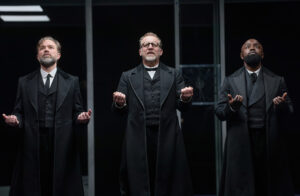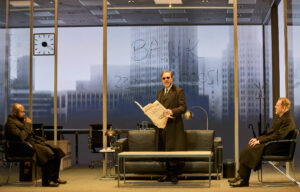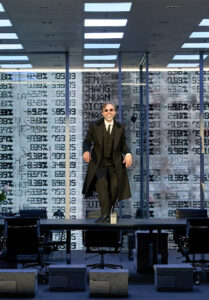Theatre at its most pure
★★★★

Lehman Brothers Inc was the highest profile bankruptcy of the 2008 financial crash. Of course there were bigger investment banks in America that played an even bigger part in the collapse of the financial markets and many banks, in the UK as well as the US, ended up being bailed out with our money. But it was important that someone got punished and Lehman was not in the category of ‘too big to fail’.
We are all still suffering from that collapse and subsequent bailout, of course, but at least one good thing came out of it- The Lehman Trilogy. It began, as so many great shows have, at the subsidised National Theatre, went on to the West End then to Broadway and now it’s back in the West End, laden with Oliviers and Tonys, at the Gillian Lynne theatre. With a new cast. So do they measure up to the originals, and what is it that has made a play about a subject as dry as finance such a huge success?
The Lehman Trilogy asks the question, how did a company as important and powerful as Lehmans end up being so reckless and destructive. To find out we travel back to when Henry Lehman and his two younger brothers first came to America back in 1844.
It’s an epic story told on a large stage. At the centre is a large box in which the action takes place. Parts of it are glazed, and the inside is divided into spaces by glass. It is the kind of modern characterless glass office occupied by financial institutions everywhere. It is decorated with a desk, a boardroom table, and lots of boxes used for transporting files- memorably seen as sacked employees carried them out of the building.
We start with the moment Lehmans went bust. Everything that happens in the 164 years leading up to that moment takes place in that space, so we never forget where we’re heading. At the back and sides of the stage, designer Es Devlin has placed a semi-circular wall onto which projects appropriate landscapes that give us a visual context- the cotton fields of Alabama that provided the Lehmans with their first trading opportunity to the skyscrapers of New York.

As I said, the scale of the story is epic, the set feels epic, yet amazingly, just three actors play not only those three brothers but the succeeding generations and everyone they come in contact with. They tell us the story, and act it out, sometimes without even carrying out the actions they are describing. At one point, a character says about himself ‘he adjusts his tie’ but he doesn’t actually do it. Our own imagination creates the epic.
Myriad characters come and go, often briefly but vividly sketched. The actors, without changing costumes, become children, brides-to-be, cotton farmers, and many more. This leads to a lot of comedy but it also means they never quite stop being, nor can we forget, those immigrant brothers who started it all.
It is the purest kind of acting that relies not on props or costumes but entirely on voice and body. They speak a rhythmic language that verges on poetry or perhaps more accurately rap. In fact, much of this play’s power comes from Ben Powers’ adaptation of Stefano Massini’s Italian original script.
It’s a Brechtian way of telling a story, interesting, funny and gripping but not emotionally involving, which is reinforced by it taking place within a glass box. So, we always see that this is a story not of a family but of American capitalism.
It is an acting tour de force from Michael Balogun, Hadley Fraser and Nigel Lindsay. There is one wonderful moment I remember when Hadley Fraser plays eight different potential brides in rapid succession. Or the same actor, who I would have to say was the first among equals, briefly plays a man described as someone whose body is built around his smile. And it is.
So, in three acts, we see the brothers committed to their Alabama community trading in actual goods- cotton- buying , selling and transporting it. Helping rebuild the cotton trade after a disastrous fire. At first, you admire their ability also to see disasters as opportunities.
The new generation born in America begin to forget their Jewish roots: shiva when the first brother dies lasts seven days, the next three days, then, so anxious are they not close the business, three minutes silence for the last of the brothers.
Money becomes all important. They no longer trade in something physical- they never see the coffee or iron or other commodities. They trade shares not products. As the new generations succeed the old, the Lehmans become shareholders not partners so they have much less to lose, and the risks become greater. After a period of regulation following the Wall Street Crash, the American idea of liberty, so inspiring but also so potentially damaging, re-emerges and the scene is set for the final disaster.
It’s a salutary tale that makes you admire these entrepreneurs, then despise the heartless money grabbers they become, while laughing at the sheer lunacy of ithe world of finance.

The third act tails off a little as the final Lehman dies, without any of them suffering the consequences of their actions. It is others that take the company and the financial world over the edge. But not without a , as they found out when the music stopped moment when a metaphor of dancing sees the last of the Lehmans, again it’s Hadley Fraser, no longer making decisions but simply standing on a table doing the twist, as the computer coding spins across the back projection, showing the algorithms that have taken over from human beings, making him and his colleagues more and more money but taking them further and further from the real world. It is literally dizzying, as dizzying as the bankers found it trying to understand their own complicated and ultimately worthless financial packages, which became apparent when the music stopped. A special word of praise to the video designer Luke Halls.
This may not be a story that you can get emotionally involved in, but this is Theatre at its finest, thanks to director Sam Mendes and his writers.
If you haven’t already seen it, don’t miss this opportunity.
The Lehman Trilogy can be seen at the Gillian Lynne Theatre until 20 May 2023
Paul was given a review ticket by the producers
Click here to watch this review on the YouTube channel Theatre.Reviews With Paul Seven